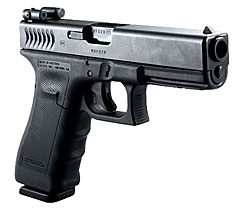SayUncle has a picture of what is purported to be the Gen 4 Glock pistol due out in January 2010. The picture clearly shows the interchangeable back straps and new texture on the grip. The magazine release appears larger than the current generation.
The model designation on the slide is slightly changed, adding a “Gen 4” next to the model number.
The photo, if real, also shows the other outward appearances of the pistol to be largely unchanged. The rear slide serrations are typical of the standard Glock pistols, not those of the RTF2 models. The finger ridges on the front of the grip are still there (some hate ’em, others love them).
Thanks to SayUncle for breaking this news. Go over to SayUncle for a large photo, and to read his take on the photo.
Previous: Pistol-training.com is reporting that they received private confirmation of the new Glock models from another industry professional at the National Association of Police Equipment Distributers (NAPED).
So, despite Glock’s statements, someone at the NAPED conference is saying new adjustable grip Glock’s will be rolling out within a year. It makes me wonder if someone let something “slip” at the convention, and Glock is still putting the new models through testing.
If Glock is developing an adjustable grip pistol, and someone did release the information too soon, this puts Glock in a tough position. They could continue to deny the rumor, and hope no one else leaks additional information.
On the other hand, if they were to announce the new pistol now, they would likely be doing so well in advance of the completion of testing and development of the guns. So, announcing and then failing to deliver could create a major PR debacle.
Pistol-training.com’s source puts the roll-out time around the 2010 SHOT Show, which would seem to make sense.





